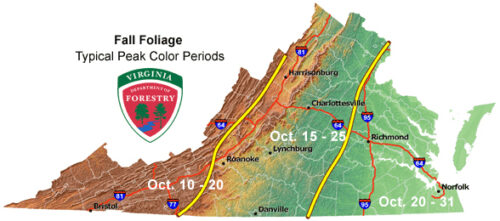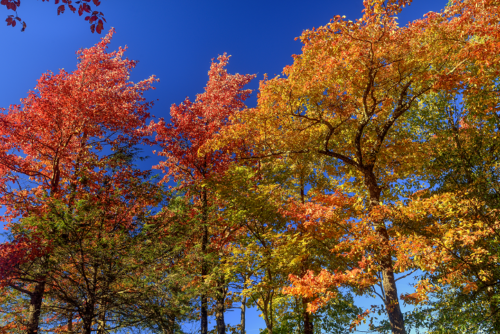Fall Foliage in Virginia
 Virginia is diverse in landscape, from the highest mountains to the Eastern Shore. The variety in landscape and elevation provides a long fall foliage season, starting earliest in the higher elevations and moving eastward. Fall colors generally peak sometime between October 10 and October 31; however, these dates can vary from year to year, based on factors such as temperature and rainfall.
Virginia is diverse in landscape, from the highest mountains to the Eastern Shore. The variety in landscape and elevation provides a long fall foliage season, starting earliest in the higher elevations and moving eastward. Fall colors generally peak sometime between October 10 and October 31; however, these dates can vary from year to year, based on factors such as temperature and rainfall.
Virginia’s many species of deciduous trees create an interesting mix of autumn colors. Here are some colors you can expect from some of our most common species:
| Tree | Color | Timing in Fall Season |
| Black Gum | Bright red | Early |
| Dogwood | Red to maroon | Early |
| Tulip-poplar | Yellow | Early |
| Red Maple | Orange to brilliant scarlet | Middle |
| Sugar Maple | Bright orange | Middle |
| Beech | Yellow to orange | Middle |
| Hickory | Gold | Middle |
| Oaks | Deep red, amber, russet | Late |

General timing of fall foliage season, in years of typical rainfall and temperatures
Week of Oct. 10-17, 2022
Weekly Fall Foliage Report
October 12 —
A lot has happened to Virginia’s fall foliage in the past week! Thanks to the cool nights and bright sunny days, most areas in central, northern, and western regions are now sporting autumn colors.
High elevation forests in southwest Virginia and the Alleghenies will peak this weekend, with a few areas already past peak. Most of the lower mountains have around 50% color change. However, areas with abundant oak trees still appear green, as the oaks change later than most species.
In the Piedmont, the overall effect is moving toward gold, accented with red from maples, black gum, dogwood, and sumac. The Coastal Plain is beginning to color as well, especially along city streets and in wet areas like swamps.
Species to note along Virginia roadways are deep red dogwoods, bright red to orange maples, and red Virginia creeper vines clinging to tree trunks. Tulip-poplar, sycamores, and hickories contribute shades of yellow.
- Flag Rock Recreation Area near Norton (photo by Wayne Browning)
- Pickem Mountain, Wise County (photo by Wayne Browning)
- Fall Foliage Report – (800)424-LOVE (begins mid-late September each year)
- Blue Ridge Parkway – (828)298-0398 (press “3”)
- George Washington and Jefferson National Forest
- Smoky Mountains Fall Foliage Prediction Map
- All things Fall In Virginia from the Virginia Tourism Corporation
- Find a state forest to view fall color
- Prince William Forest Park is an oasis of natural beauty and human history located just south of Washington, DC.
Fall Foliage Driving Tours
Try our VDOF-recommended Fall Foliage Driving Tours.
Why Leaves Change Color
- Chlorophyll gives leaves their familiar green color.
- Carotenoids produce yellow, orange, and brown colors.
- Anthocyanins produce red and purple colors and are the same pigments that give color to fruits like blueberries and cherries.
Both chlorophyll and carotenoids are present in the leaf cells throughout the growing season. During this time, chlorophyll is produced and leaves appear green. As days get shorter, chlorophyll production slows and eventually stops. With the green color no longer visible, the yellow carotenoids are revealed. During autumn, bright light and excess plant sugars produce red anthocyanins within leaf cells.

























